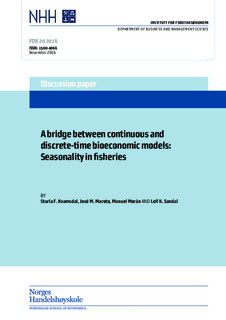| dc.description.abstract | We develop a discretization method for continuous-time bioeconomic models. Based on this method, we develop a discrete-time bioeconomic model to analyze seasonality in fisheries. The discretization method consists of three steps: first, we estimate a proper growth function for the continuous-time model with the ensemble Kalman Filter. Second, we use the Runge-Kutta method to discretize the growth function. Third, we use the Bellman approach to analyze optimal management of seasonal fisheries in a discrete-time setting. We analyze both the case of quarterly harvest and the case of monthly harvest, and we compare these cases with the case of annual harvest. We find that seasonal harvesting is a win-win optimal solution with higher harvest, higher optimal steady state equilibrium, and higher economic value than obtained in the case of annual harvesting. We also demonstrate that the discretization method overcomes the errors and preserves the strengths of both continuous and discrete-time bioeconomic models. | nb_NO |
